
Architectural Styles and Revivals: Romanesque Revival Homes
(Written by Dr. Les Crocker, UWL Emeritus Professor of Art History)
This blog is third in a series on the Romanesque Revival. For more background on this revival, see Architectural Styles & Revivals: Romanesque Revival Public Buildings.
The Romanesque Revival was all about masses and large-scale forms. Most houses don't have the size to show the style well. The best examples, in the eastern states, show great stone structures with small windows, massive towers and rusticated walls.
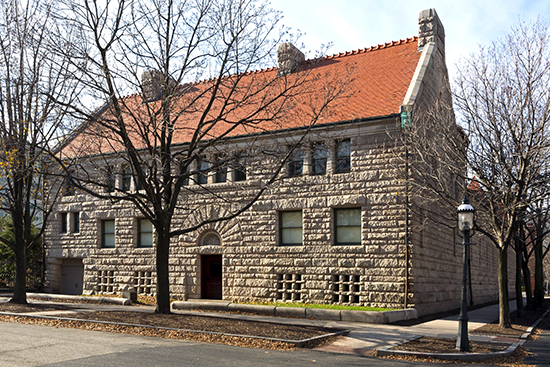
Glessner House, Chicago, H.H. Richardson. The massive walls and small windows never became very popular with most wives.
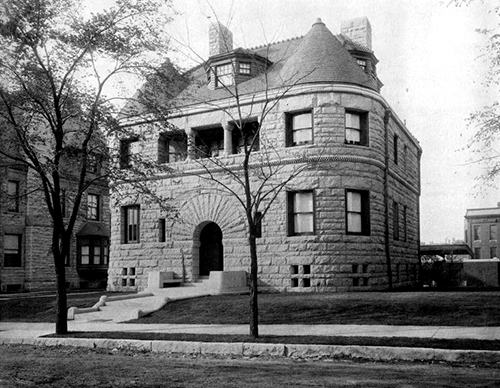
Lionberger House, St Louis. The stone of the basement walls rise out of the earth and become the walls of the house with no dividing line. Towers on the front corners were often used in the Queen Anne style also. Stubby columns reject the classical styles. The long wedges that make up the arch over the entrance imply they are supporting great weight. A single band of slightly darker stone defines the two floors. Small five-sided dormers sit between the tower caps.

Looking south from Main St. down West Ave. in 1892 we see the Gile, Platz 1884, and Perry 1892 houses with the rear of the Paul house in the distance. Platz and Perry built Queen Anne style houses. Well rutted dirt streets indicate a late winter date for this photo.
“Pasadena”, Abner & Mary Gile House, 110 West Ave. and 1180 Main St., 1887 Demolished 1967
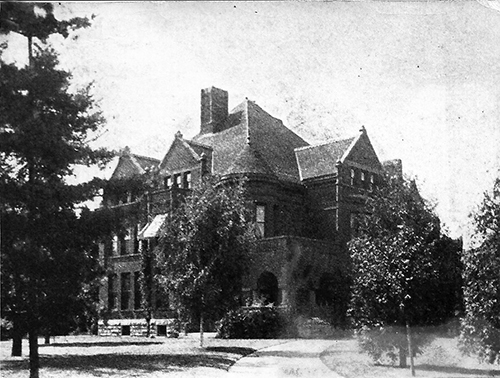
“Pasadena” occupied the SW corner of Main St. & West Ave., where the Dahl YMCA currently stands.
Abner Gile was born in Gainesville, New York in 1820. He married Mary E. Smith in 1843. There was no better way to make money in a new town that owning a sawmill. After arriving in La Crosse, Gile built two of them. His wife Mary died in 1877, but Abner didn’t slow down. In 1882 he founded the Electric and Gas Lighting Co. At that time, it was unclear whether gas jets or electric bulbs would provide the illumination of the future so he covered both possibilities. He was vice-president of the Batavian Bank from 1883 until his death in 1897. He owned a linseed oil company, a pork packing operation and timber land all over the west and south.
Abner began his new brick house in 1886 and finished it the following year at a cost of $45,000. He only lived there a decade before his death in 1897. Gile was worth over a million dollars when he died. At a time when there were very few millionaires in the world; he was probably the richest man in La Crosse. Many consider this to be the grandest of all the houses in La Crosse, but we have few images of it.
The house was Richardsonian Romanesque, the only true example of that massive style in La Crosse. The main unit is a large square with a pyramidal roof. A section extends out from the front and another one from the north face, to the right in this photo. There is a two story round tower on the northeast corner, an entrance beside it, and a port-cochere to the right of that. The round arch in the entrance pavilion rests on short columns. There is a similar arch for the port-cochere, a covered area next to the house for loading and unloading the carriage in bad weather.
Massive is the word for the Romanesque Revival style house. It is in complete contrast to the Queen Anne style that used wooden forms that were delicate and lightweight. Compare this tower with that of the Gantert house, built three years later.
Pasadena was bought in 1931 for $23,000 by the YWCA and used until their new building was built in 1968. The Gile house was demolished in October of 1967. Like the Easton, Cargill, and other mansions of the 1880s and 1890s, it was too big for a world without live-in, low-wage servants.
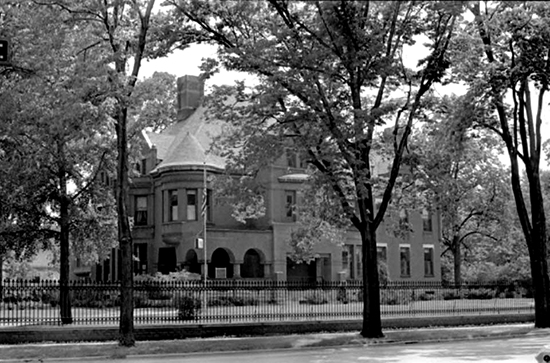
A later view of Pasadena’s Main St. side; the young trees in the previous photo have grown. Photo courtesy of Jim Hurley.
The John Paul House, 1133 Cass St.
The John Paul house at 1133 Cass street was part of the building boom of large houses that began in the 1870's. Although quite large it was never a very distinguished house. The most distinctive features were two bay windows two stories high on the front and a large cupola on the roof that was later removed, like most cupolas in town.
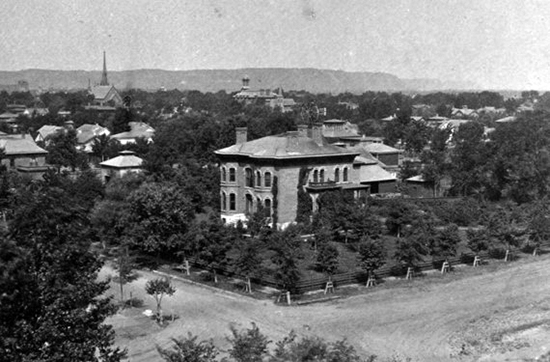
This photo, likely taken from the tower of the McMillan house, provides a great view of the Romanesque features of the John Paul house, as well as some landmarks in the background.

The cupola on the Paul house can be seen in the background. Photo courtesy of Mark Hyde.
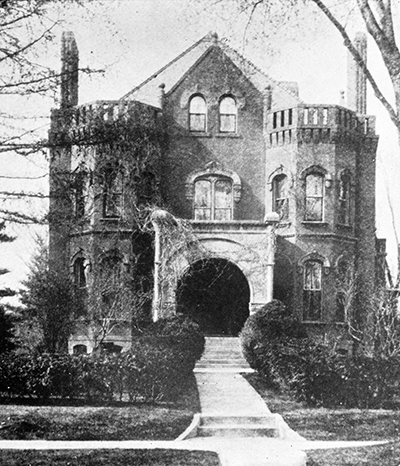
The new front of John Paul's house had a huge Romanesque arch that did not fit with the older part of the house.
The John Hughes House, 1337 State St., 1893
The John Hughes House was designed by Andrew Roth in 1893, although not completed until 1895. Hughes was part of Sees & Hughes contractors and probably built his house. Roth was the son of a local carpenter and made himself into an architect by working, probably as a draftsman, for C. J. Ross and later with Hugo Schick. The Fourteenth Street side is subtle, the State street side has impact!
The ground floor has a basic entrance and a large parlor window for the time. Cast-iron plates could easily span the distance between supporting walls so houses around 1890 begin to show larger window openings. The porch is simple with columns suited to the scale of the porch. Its most notable feature is a pediment to mark the entrance. The porch pediment, if it was entirely visible, would be the same size as the pediment above the bay window.
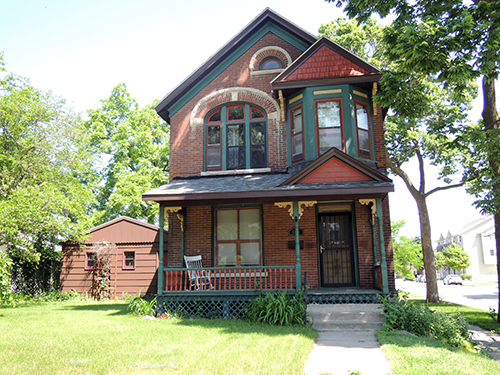
The John Hughes house, looking from State St. 2013 photo by author.
This rectangular house on a small lot imitates a Three Gable type, but the side wings barely exist except as an excuse for the grand gable on each side. This is not a criticism; the architect was faced with a large mass of brick on the side walls. Using the shallow wing with decorated gable breaks up the mass. The window placement on both floors beneath the gable is outstanding, as is the brickwork of the window heads. This side of the house clearly shows how a skilled designer can overcome severe limitations.

A view of the side of the house from Fourteenth St. The brackets supporting the triangular gable with a pent roof and those supporting the triangular section at the peak of the gable are noteworthy details of the Queen Anne style. 2013 photo by author.
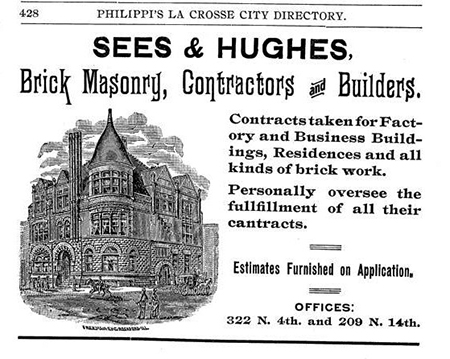
The company's ad in the 1895 city directory says that Sees & Hughes were masonry contractors. The engraving was a standard printshop image, not a house built in La Crosse.
316 West Ave. N.
This medium-sized house with a side entrance, uses its front to show off the well-proportioned arch outlined in limestone on the upper level with a porthole window also edged in limestone above it. A limestone raised basement gives it a considerable impact as does the horizontal line of white stone between the lower and upper floor. It was probably designed by Andrew Roth.
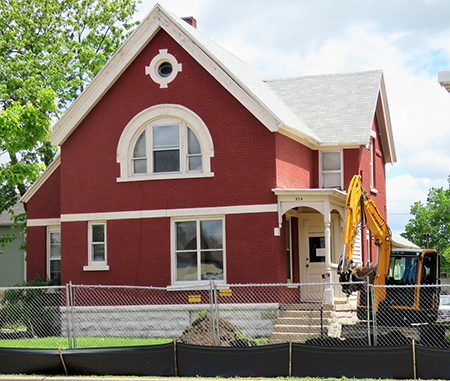
A recent photo of the home just prior to demolition. 2019 photo by Anita Taylor Doering.
Holway House, 1419 Cass St., 1891
Although the Holway house was built of stone and has some Romanesque features, the overall style is from the Queen Anne style, particularly the strong upward emphasis of the corner tower and the gables on each side of it. Like so many houses in La Crosse it is a mixture of styles.

The Holway House; at first glance it could be interpreted as Romanesque Revival, but is actually of the Queen Anne Style. Photo by author.
Check back next week for the final installment in both the Romanesque Revival series and the Architectural Styles & Revivals series as a whole. Since this revival was born out of religious architecture, we will focus on the many churches built in La Crosse in this style.
Other entries in this series
Architectural Styles and Revivals
Architectural Styles and Revivals: The Greek and Roman Revivals
Architectural Styles and Revivals: The Gothic Revival
Architectural Styles and Revivals: The Exotic Revival
Architectural Styles and Revivals: The Italianate Style
Architectural Styles and Revivals: The Second Empire Style
Architectural Styles and Revivals: The Queen Anne Style
Architectural Styles and Revivals: The Colonial Revival
Architectural Styles and Revivals: Romanesque Revival Public Buildings
Architectural Styles and Revivals: Romanesque Revival Commercial Buildings
Architectural Styles and Revivals: Religious Romanesque
